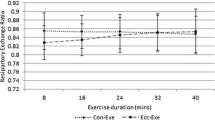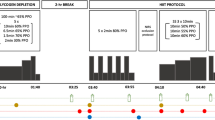Abstract
Purpose
Exercise-induced muscle damage and lowered glycogen are common during heavy training periods, and may prolong recovery. We examined the effects of lowered glycogen on cardiorespiratory, metabolic and perceptual responses to downhill running.
Methods
Twelve men performed two downhill runs (−12 % gradient, 12.1 ± 1.1 km h−1) separated by 6 weeks, under normal (NORM) and reduced glycogen (RED) conditions in a crossover design. For RED, participants performed exhaustive cycling at 60 % \(\dot{V}\)O2max power (95 ± 13 min) in the evening, and the next morning completed a downhill run comprising of five stages of 8 min running, with 2 min recovery (1 % gradient, 8 km h−1) between each stage. Expired gas, heart rate, rating of perceived exertion (RPE) and blood lactate (bLa) and glucose were measured for each stage.
Results
Blood glucose (P < 0.05) and respiratory exchange ratio (P < 0.01) were lower in RED, than NORM, throughout the downhill run. RED demonstrated higher bLa until stage Four (P < 0.05), and RPE for stages Two and Five (P < 0.05).Ventilatory equivalent of carbon dioxide output (\(\dot{V}_{E}\)/\(\dot{V}{\rm CO}_{2}\)) was higher for stages One (P < 0.01), Two and Five (P < 0.05), and oxygen uptake (\(\dot{V}\) E/\(\dot{V}\)O2) was lower for stages Three and Four (P < 0.05) for RED.
Conclusions
Downhill running with reduced glycogen, elevated fat oxidation and bLa response, and, in part, increased effort perception. The alterations in \(\dot{V}\) E/\(\dot{V}\)O2 and bLa may suggest that carbon dioxide removal was somewhat impaired.


Similar content being viewed by others
Abbreviations
- bLa:
-
Blood lactate
- DOMS:
-
Delayed onset muscle soreness
- HR:
-
Heart rate
- NORM:
-
Normal glycogen
- RED:
-
Reduced glycogen
- RER:
-
Respiratory exchange ratio
- RPE:
-
Rating of perceived exertion
- \(\dot{V}{\text{CO}}_{ 2}\) :
-
Carbon dioxide output
- \(\dot{V}_{\text{E}}\) :
-
Minute ventilation
- \(\dot{V}_{\text{E}}\)/\(\dot{V}\)CO2 :
-
Ventilatory equivalent of carbon dioxide
- \(\dot{V}_{\text{E}}\)/\(\dot{V}\)O2 :
-
Ventilatory equivalent of oxygen uptake
- \(\dot{V} {\text{O}}_{ 2}\) :
-
Oxygen uptake
- \(\dot{V} {\text{O}}_{{ 2 {\text{max}}}}\) :
-
Maximal oxygen uptake
References
Asp S, Daugaard JR, Richter EA (1995) Eccentric exercise decreases glucose transporter GLUT-4 protein in human skeletal muscle. J Physiol 482:705–712
Baumann CW, Green MS, Doyle JA, Rupp JC, Ingalls CP, Corona BT (2014) Muscle injury after low-intensity downhill running reduces running economy. J Strength Cond Res 28:1212–1218
Borg G (1998) Borg’s perceived exertion and pain scales. Human Kinetics, Champaign
Bouckaert J, Jones AM, Koppo K (2004) Effect of glycogen depletion on the oxygen uptake slow component in humans. Int J Sports Med 25:351–356
Braun WA, Dutto DJ (2003) The effects of a single bout of downhill running and ensuing delayed onset of muscle soreness on running economy performed 48 h later. Eur J Appl Physiol 90:29–34
Caiozzo VJ, Davis JA, Ellis JF, Azus JL, Vandagriff R, Prietto CA, McMaster WC (1982) A comparison of gas exchange indices used to detect the anaerobic threshold. J Appl Physiol 53:1184–1189
Clarkson PM, Sayers SP (1999) Etiology of exercise-induced muscle damage. Can J Appl Physiol 24:234–248
Craig CL, Marshall AL, Sjöström M, Bauman AE, Booth ML, Ainsworth BE, Pratt M, Ekelund U, Yngve A, Sallis JF, Oja P (2003) International physical activity questionnaire: 12-country reliability and validity. Med Sci Sports Exerc 35:1381–1395
Eston RG, Mickleborough J, Baltzopoulos V (1995) Eccentric activation and muscle damage: biomechanical and physiological considerations during downhill running. Br J Sports Med 29:89–94
Eston RG, Lemmey AB, McHugh P, Byrne C, Walsh SE (2000) Effect of stride length on symptoms of exercise-induced muscle damage during a repeated bout of downhill running. Scand J Med Sci Sports 10:199–204
Faul F, Erdfelder E, Lang AG, Buchner A (2007) G*Power 3: a flexible statistical power analysis program for the social, behavioral, and biomedical sciences. Behav Res Methods 39:175–191
Fridén J, Sjostrom M, Ekblom B (1983) Myofibrillar damage following intense eccentric exercise in man. Int J Sports Med 4:170–176
Holloszy JO, Kohrt WM, Hansen PA (1998) The regulation of carbohydrate and fat metabolism during and after exercise. Front Biosci 15:1011–1027
Hughes EF, Turner SC (1982) Effects of glycogen depletion and pedaling speed on “anaerobic threshold”. J Appl Physiol Respir Environ Exerc Physiol 52:1598–1607
Krishnan RK, Evans WJ, Kirwan JP (2003) Impaired substrate oxidation in healthy elderly men after eccentric exercise. J Appl Physiol 94:716–723
Krustrup P, Soderlund K, Mohr M, Bangsbo J (2004) Slow-twitch fiber glycogen depletion elevates moderate-exercise fast-twitch fiber activity and O2 uptake. Med Sci Sports Exerc 36:973–982
Maehlum S, Hermansen L (1978) Muscle glycogen concentration during recovery after prolonged severe exercise in fasting subjects. Scand J Clin Lab Invest 38:557–560
Meyer K, Steiner R, Lastayo P, Lippuner K, Allemann Y, Eberli F, Schmid J, Saner H, Minetti AE, Moia C, Roi GS, Susta D, Ferretti G (2002) Energy cost of walking and running at extreme uphill and downhill slopes. J Appl Physiol 93:1039–1046
Minetti AE, Moia C, Roi GS, Susta D, Ferretti G (2002) Energy cost of walking and running at extreme uphill and downhill slopes. J Appl Physiol 93:1039–1046
Newell J, Higgins D, Madden N, Cruickshank J, Einbeck J, McMillan K, McDonald R (2007) Software for calculating blood lactate endurance markers. J Sports Sci 25:1403–1409
O’Reilly KP, Warhol MJ, Fielding RA, Frontera WR, Meredith CN, Evans WJ (1987) Eccentric exercise-induced muscle damage impairs muscle glycogen repletion. J Appl Physiol 63:252–256
Osborne MA, Schneider DA (2006) Muscle glycogen reduction in man: relationship between surface EMG activity and oxygen uptake kinetics during heavy exercise. Exp Physiol 91:179–189
Paschalis V, Koutedakis Y, Jamurtas AZ, Mougios V, Baltzopoulos V (2005) Equal volumes of high and low intensity of eccentric exercise in relation to muscle damage and performance. J Strength Cond Res 19:184–188
Perrey S, Betik A, Candau R, Rouillon JD, Hughson RL (2001) Comparison of oxygen uptake kinetics during concentric and eccentric cycle exercise. J Appl Physiol 91:2135–2142
Scott KE, Rozenek R, Russo AC, Crussemeyer JA, Lacourse MG (2003) Effects of delayed onset muscle soreness on selected physiological responses to submaximal running. J Strength Cond Res 17:652–658
Segal SS, Brooks GA (1979) Effects of glycogen depletion and work load on postexercise O2 consumption and blood lactate. J Appl Physiol Respir Environ Exerc Physiol 47:514–521
Thomas JR, Salazar W, Landers DM (1991) What is missing in p less than.05? Effect size. Res Q Exerc Sport 62:344–348
Thomson JA, Green HJ, Houston ME (1979) Muscle glycogen depletion patterns in fast twitch fibre subgroups of man during submaximal and supramaximal exercise. Pflugers Archiv 379:105–108
Twist C, Eston RG (2009) The effect of exercise-induced muscle damage on perceived exertion and cycling endurance performance. Eur J Appl Physiol 105:559–567
Vøllestad NK, Vaage O, Hermansen L (1984) Muscle glycogen depletion patterns in type I and subgroups of type II fibres during prolonged severe exercise in man. Acta Physiol Scand 122:433–441
Widrick JJ, Costill DL, McConell GK, Anderson DE, Pearson DR, Zachwieja JJ (1992) Time course of glycogen accumulation after eccentric exercise. J Appl Physiol 72:1999–2004
Yamanaka R, Yunoki T, Arimitsu T, Lian CS, Roghayyeh A, Matsuura R, Yano T (2012) Relationship between effort sense and ventilatory response to intense exercise performed with reduced muscle glycogen. Eur J Appl Physiol 112:2149–2162
Conflict of interest
The authors declare no conflicts of interests.
Author information
Authors and Affiliations
Corresponding author
Additional information
Communicated by Michael Lindinger.
Rights and permissions
About this article
Cite this article
Gavin, J.P., Myers, S.D. & Willems, M.E.T. The effect of glycogen reduction on cardiorespiratory and metabolic responses during downhill running. Eur J Appl Physiol 115, 1125–1133 (2015). https://doi.org/10.1007/s00421-014-3094-4
Received:
Accepted:
Published:
Issue Date:
DOI: https://doi.org/10.1007/s00421-014-3094-4




